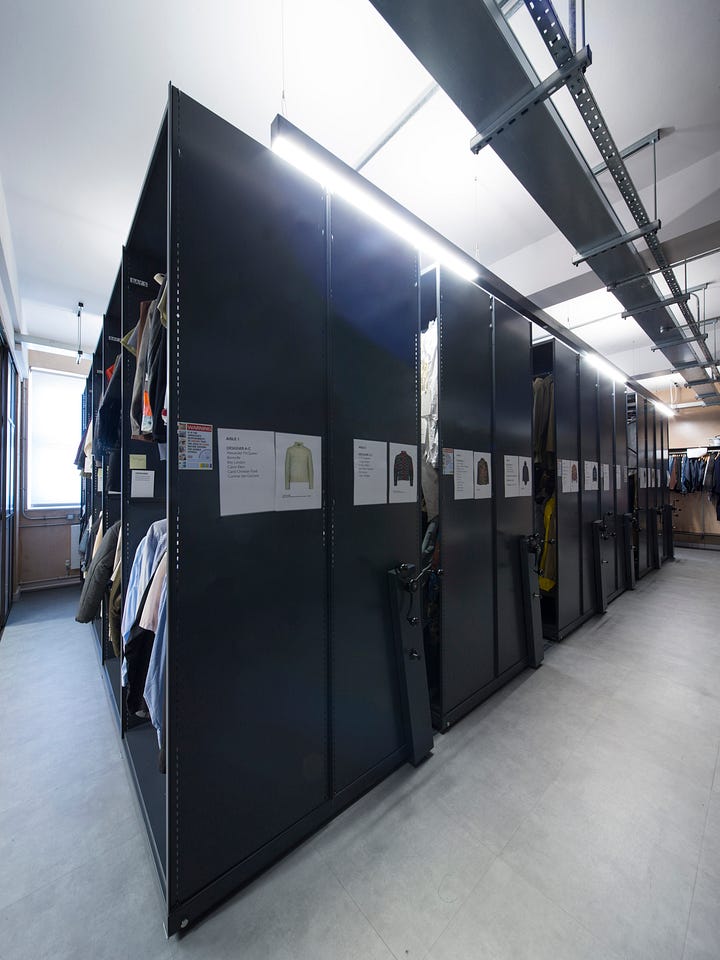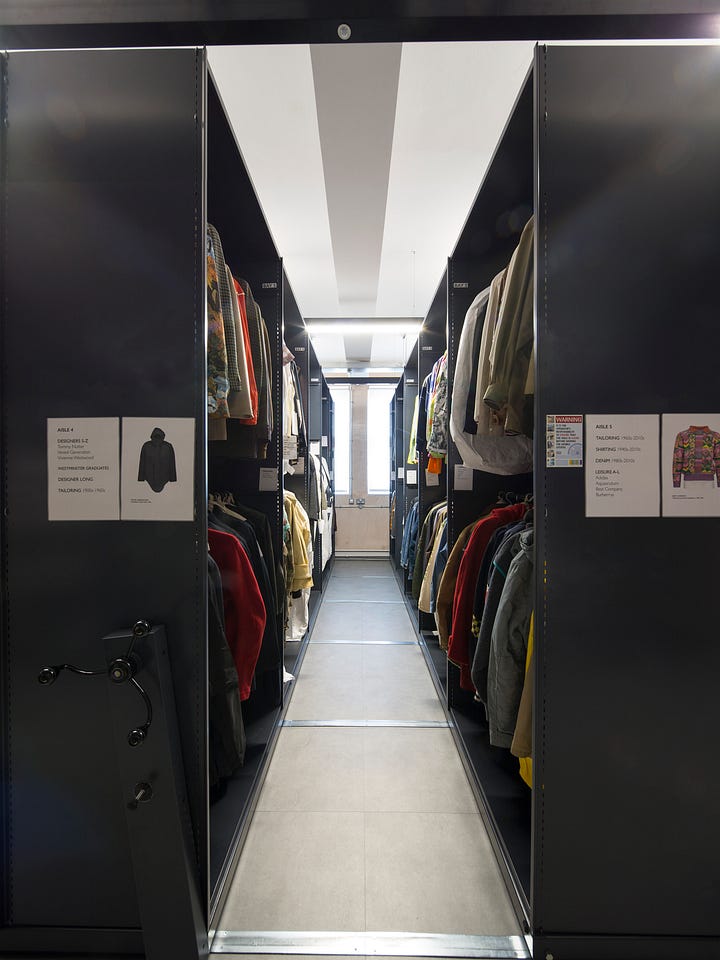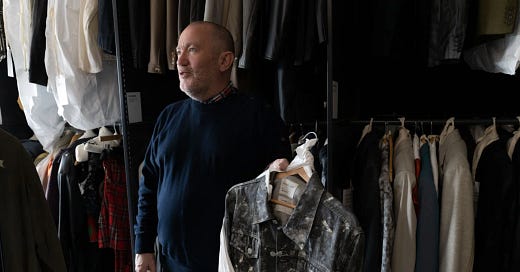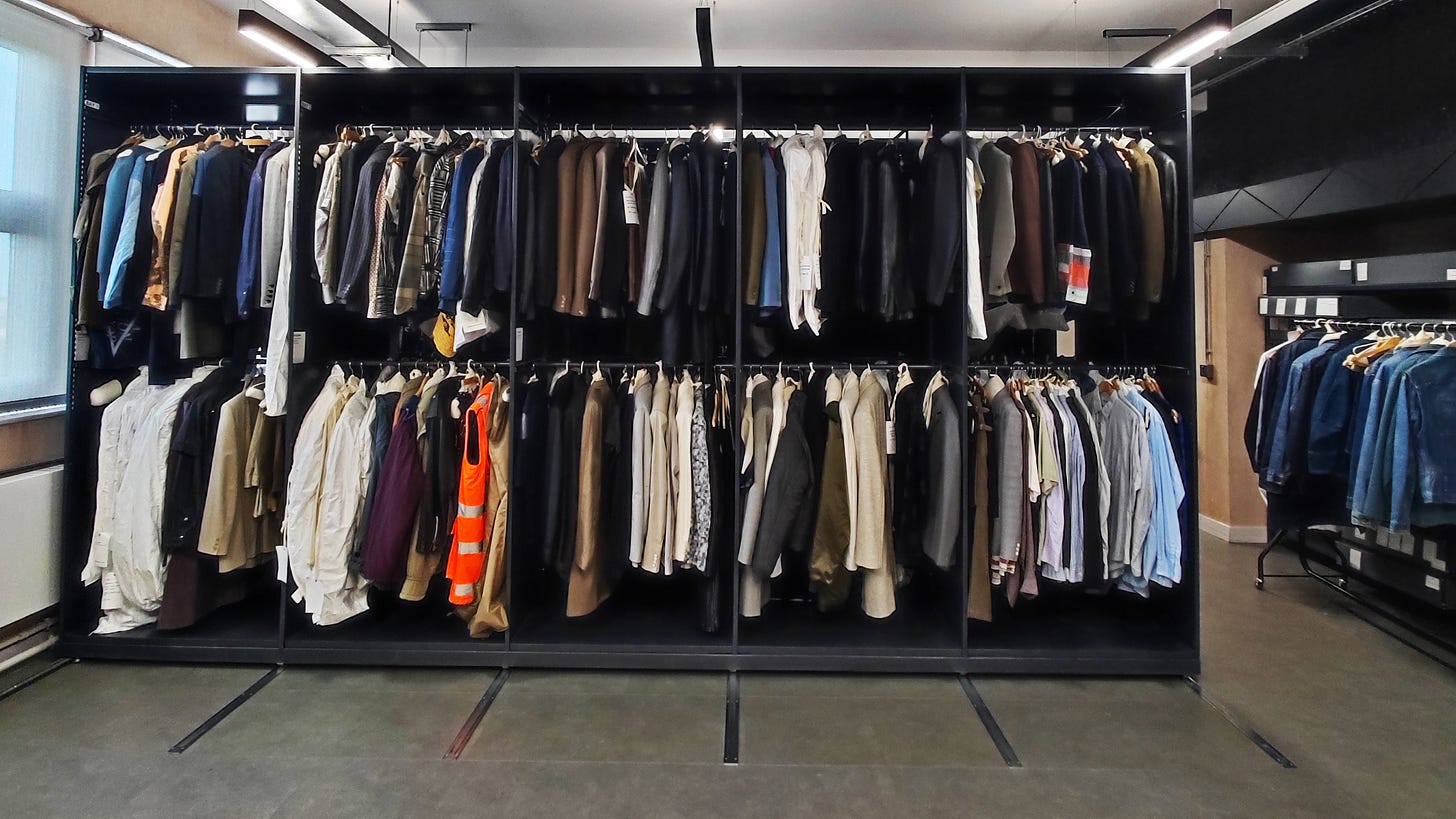A man who has lived many lives—and all of them in fashion—Andrew Groves is the penultimate sartorial trend shape-shifter. His bio is nothing short of fascinating-from torching taboos on the London catwalk with 30-foot burning crucifixes and models dusted in faux cocaine, to rewriting the script on modern fashion education, Groves has never done things by halves.
Once McQueen’s head assistant and the anarchic mind behind cult '90s label Jimmy Jumble, he later channeled his renegade energy into the demanding world of academia, becoming a Professor of Fashion Design at the University of Westminster. There, he didn’t stay still, he masterminded the Westminster Menswear Archive—the world’s first of its kind—and oversaw the BA Fashion course to match the pace of the international fashion calendar, making it the first undergraduate course to land on the official London Fashion Week schedule.
Inside this adventurous bio, the Westminster Menswear Archive really stands out- it houses over 2,000 examples of British menswear including garments from Craig Green, Joe Casely-Hayford, Kim Jones, Aitor Throup, Vivienne Westwood, Nigel Cabourn, Meadham Kirchhoff.
Today Groves talks about the challenges of establishing an archive of this kind and how having a clearly defined aesthetic point of view is key for any emerging fashion designer.
The Westminster Menswear Archive is unique in its focus. What gaps in fashion history or education were you aiming to fill when you founded it?
When I established the Westminster Menswear Archive in 2016, it was to address the lack of dedicated resources for studying menswear in an academic or curatorial context. Fashion archives and museum collections have historically prioritized elite womenswear when telling the narrative of fashion. In comparison, the collection and study of menswear has been very much neglected.
In doing so, it denies us the ability to truly understand fashion, since so much is missing. If you studied Alexander McQueen’s early womenswear which drew on his extensive firsthand knowledge of Savile Row tailoring, you are unable to study his menswear from the same period that informed his approach. So the archive is an attempt to rectify that absence. It provides students, researchers, and designers with direct access to garments that showcase the construction, material innovation, and historical context of menswear. It fills a critical gap by ensuring that menswear is studied with the same level of depth and rigor as womenswear.
Archiving is often seen as a way to preserve fashion history, but do you see it also shaping the future of menswear design?
Absolutely. The archive isn’t just about preserving the past; it’s an active resource for shaping the future of menswear. Designers regularly engage with the collection to study techniques, understand historical references, and develop ideas that push their work forward. Many brands use the archive as a research tool, whether to refine existing design languages or to innovate new ones. By offering this access, the archive acts as a conduit between historical research and contemporary practice, ensuring that knowledge from the past informs and enhances future design.
From punk to rave culture, British subcultures have often been defined by their clothing. Do you think social media has made subcultural fashion more homogenized or more diverse?
Social media has changed the way subcultures form and evolve. While it has undoubtedly made certain aesthetics more accessible and widely adopted, reducing the sense of exclusivity that once defined subcultures, it has also allowed niche styles to thrive in ways that wouldn’t have been possible before. There is now a hyper-awareness of subcultural references, leading to a blending of styles rather than a single, dominant look. The challenge is that when subcultural fashion is rapidly commodified, it can lose some of its deeper meaning and become just another trend cycle.
Many of your students—Steven Stokey-Daley, Robyn Lynch, Priya Ahluwalia, and Paolo Carzana—have developed distinct design signatures. What qualities did they show as students that hinted at their future success?
Each of them had a clear point of view from the start, which is critical. They were all highly engaged in research, whether through archival work, personal history, or cultural references, and they understood how to translate that into their designs. They also had a strong work ethic and a willingness to refine their ideas over time. What set them apart was their ability to balance conceptual thinking with technical execution. Having a compelling narrative is one thing, but knowing how to metamorphize that into a highly desirable, and beautifully constructed garment is what makes a designer stand out.
What role does archiving and historical research play in the way you teach fashion? Do students today value fashion history as much as they should?
Archival research is fundamental to how I teach. Understanding the past is essential for any designer who wants to create work with depth and relevance. The Westminster Menswear Archive provides students with first-hand access to garments that allow them to analyze construction, materiality, and historical context in ways that aren’t possible through images alone. It also allows us to critique the work of others, rather than the students, thereby enabling us to better understand the students’ point of view and aesthetics before them producing something themselves.


Looking at the evolution of menswear, is there a particular era or designer you think has been overlooked in fashion history?
Rather than identifying a particular designer, what’s more striking is the way designers who work across both menswear and womenswear often see only their womenswear included in major exhibitions. For instance, the Savage Beauty exhibition at the Met and the V&A focused solely on McQueen’s womenswear, despite his significant menswear output. Similarly, the V&A’s Dior: Designer of Dreams exhibition barely acknowledged the menswear produced under the brand, even though designers like Hedi Slimane, Kim Jones, and Marc Bohan played pivotal roles in shaping contemporary menswear under the Dior umbrella. This selective curatorial focus not only distorts our understanding of these designers' legacies but also reinforces the idea that menswear remains secondary in the broader narrative of fashion history.
From oversized silhouettes to ultra-slim tailoring, menswear has gone through radical shifts over the decades. What do you think drives these cyclical changes in proportion?
Menswear’s cyclical shifts in proportion are driven by cultural and economic changes, with silhouette being the primary marker of fashionability. Unlike womenswear, where color, print, and embellishment are more likely to drive seasonal trends, menswear evolves more slowly, with shifts often spanning decades. The suit remains a key barometer of change, its transformation reflects broader shifts in masculinity and status. As a significant financial investment, changes in its proportions and silhouette occur less frequently, making menswear’s evolution appear slower but fundamentally more significant.







love this peek behind a very specific curtain